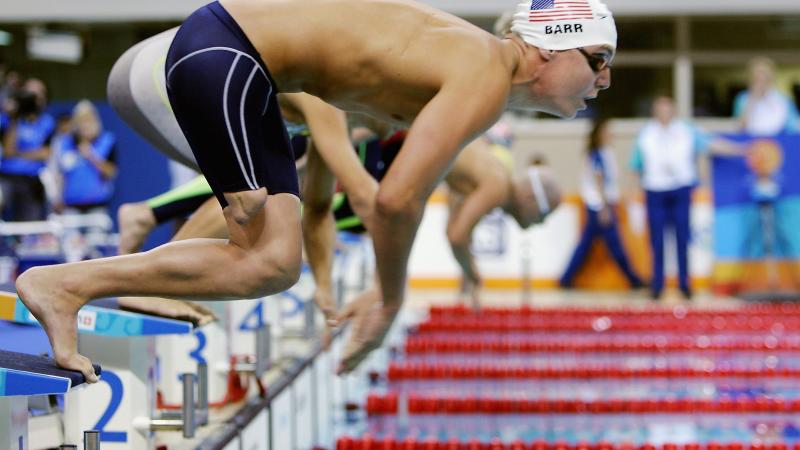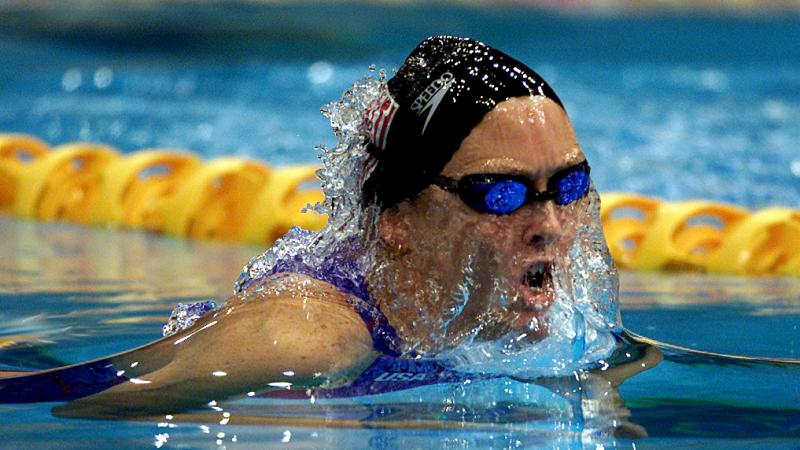HISTORY OF PARA SWIMMING
Para swimming is practised internationally by athletes in nearly 100 countries and has featured in every edition of the Paralympic Games, growing into one of the biggest and most attractive sports.
At the first Rome 1960 Paralympic Games, 77 swimmers from 15 countries competed in the sport.
World Para Swimming, under the governance of the International Paralympic Committee, acts as the international federation for the sport and is based in Bonn, Germany.
Para swimming is open to male and female athletes in all eligible impairment groups who compete in backstroke, breaststroke, butterfly, freestyle, medley and relay events.
Competition opportunities include the Paralympic Games every four years, biennial World Championships and biennial or quadrennial regional Championships.
The World Series, featuring a number of swim meetings around the world, was launched in 2017 to provide greater classification opportunities and top-level competition opportunities for athletes.
To further improve the skillset of those involved in the sport, several courses are held each year to improve the standards of national and international technical officials and classifiers.
World Para Swimming uses the same rules as its Olympic counterpart, the International Swimming Federation (FINA), with some modifications where needed. Further to ongoing contacts between World Para Swimming and FINA, there is a desire to explore opportunities for synergies in areas in which both organisations share common interests.
Para swimming was one of eight sports that made up the sport programme at the first Paralympic Games. At Rome 1960, 77 swimmers – all with spinal cord injuries – from 15 countries competed in 62 medal events. The maximum distance covered by swimmers was 50m and disciplines included backstroke, breaststroke, crawl and medley for swimmers with complete and incomplete spinal injuries.
At the Tokyo 1964 Paralympics, competition took place in the nine-lane, 50m Tokyo Metropolitan Pool because the Olympic swimming venue had been converted into an ice-skating rink. Many of the technical officials involved in the competition had also officiated the Olympic races week earlier.
Prior to the 1972 Paralympics in Heidelberg, Germany, the International Swimming Training Association for the Paralysed was founded, effectively acting as a Sport Technical Committee.
For the Toronto 1976 Paralympics, amputee and vision impaired athletes were included for the first time in the swimming programme. This led to a dramatic rise in the number of medal events, with athletes competing for 146 gold medals compared to 56 in Heidelberg.
Cerebral Palsy athletes competed for the first time at the 1980 Paralympics in Arnhem, Netherlands, and USA’s Trischa Zorn was the star performer winning seven gold medals.
In 1984 the Games were split between Stoke Mandeville, Great Britain, and New York, USA. Wheelchair athletes competed in the Paralympic Movement’s birthplace while all other impairment groups, including Les Autres – a new addition to the Games– competed in the US.
The USA’s Trischa Zorn was again the swimmer to beat at the Seoul 1988 Paralympics winning 10 gold medals.
The Sydney 2000 Paralympics saw swimmers with an intellectual impairment compete in the Games for the first time.
At the Tokyo 2020 Paralympics, 604 swimmers from 74 countries competed in 146 medal events.
GROWTH OF SWIMMING AT THE PARALYMPIC GAMES
| Year | Countries | Medal events | Male | Female | Total | TOP 3 COUNTRIES |
|---|---|---|---|---|---|---|
| 1960 | 15 | 62 | 45 | 32 | 77 | 1. ITA 2. GBR 3. NOR |
| 1964 | 13 | 63 | 65 | 33 | 98 | 1. USA 2. AUS 3. GBR |
| 1968 | 24 | 68 | 161 | 103 | 264 | 1. GBR 2. USA 3. NED |
| 1972 | 33 | 56 | 169 | 110 | 279 | 1. NED 2. POL 3. RSA |
| 1976 | 34 | 145 | 260 | 103 | 363 | 1. NED 2. ISR 3. USA |
| 1980 | 36 | 191 | 293 | 148 | 441 | 1. POL 2. CAN 3. NED |
| 1984 | 43 | 347 | 349 | 192 | 541 | 1. NED 2. USA 3. FRA |
| 1988 | 44 | 257 | 344 | 160 | 504 | 1. USA 2. SWE 3. GBR |
| 1992 | 56 | 163 | 295 | 192 | 487 | 1. USA 2. GBR 3. GER |
| 1996 | 50 | 168 | 274 | 183 | 457 | 1. GER 2. GBR 3. AUS |
| 2000 | 62 | 170 | 356 | 220 | 576 | 1. CAN 2. ESP 3. GBR |
| 2004 | 61 | 167 | 330 | 229 | 559 | 1. CHN 2. GBR 3. USA |
| 2008 | 62 | 141 | 323 | 224 | 547 | 1. USA 2. CHN 3. UKR |
| 2012 | 74 | 148 | 344 | 260 | 604 | 1. CHN 2. AUS 3. UKR |
| 2016 | 79 | 152 | 329 | 264 | 593 | 1. CHN 2. UKR 3. GBR |
| 2020 | 74 | 146 | 341 | 263 | 604 | 1. CHN 2. RPC 3. USA |
OVERALL PARALYMPIC MEDALS TABLE
| RANK | COUNTRY | GOLD | SILVER | BRONZE | TOTAL |
|---|---|---|---|---|---|
| 1 | USA | 283 | 215 | 226 | 724 |
| 2 | Great Britain | 225 | 255 | 227 | 707 |
| 3 | Netherlands | 185 | 138 | 116 | 439 |
| 4 | Canada | 164 | 124 | 122 | 410 |
| 5 | Australia | 136 | 160 | 157 | 453 |
TOP 5 FEMALE PARALYMPIC MEDALLISTS
| RANK | ATHLETE | YEARS COMPETING | GOLD | SILVER | BRONZE | TOTAL |
|---|---|---|---|---|---|---|
| 1 | Trischa Zorn (USA) | 1980-2004 | 32 | 9 | 5 | 46 |
| 2 | Beatrice Hess (FRA) | 1984-2004 | 20 | 5 | 0 | 25 |
| 3 | Jessica Long (USA) | 2004-present | 16 | 8 | 5 | 29 |
| 4 | Mayumi Narita (JPN) | 1996-2004 | 15 | 3 | 2 | 20 |
| 5 | Erin Popovich (USA) | 2000-2008 | 14 | 5 | 0 | 19 |
TOP 5 MALE PARALYMPIC MEDALLISTS
| RANK | ATHLETE | YEARS COMPETING | GOLD | SILVER | BRONZE | TOTAL |
|---|---|---|---|---|---|---|
| 1 | Mike Kenny (GBR) | 1976-1988 | 16 | 0 | 0 | 16 |
| 2 | Ihar Boki (BLR) | 2012-present | 16 | 1 | 1 | 18 |
| 3 | Daniel Dias (BRA) | 2008-2020 | 14 | 7 | 6 | 27 |
| 4 | Michael Edgson (CAN) | 1984-1992 | 14 | 2 | 0 | 16 |
| 5 | Mathew Cowdrey (AUS) | 2004-2012 | 13 | 7 | 3 | 23 |
World Para Swimming’s vision is to enable Para athletes to showcase their abilities and fulfil their full potential at all levels from the grassroots through to the high-performance level.
Its mission is to develop a long-term competition calendar which encourages and increases athlete participation, provides high levels of professional officiating and classification, fair competition, and boosts the profile of the sport and its athletes.

 Facebook
Facebook
 Instagram
Instagram
 Twitter
Twitter
 Youtube
Youtube
 Tiktok
Tiktok


